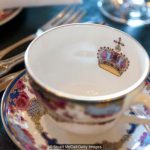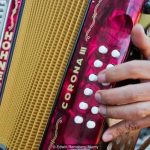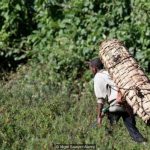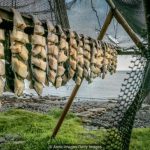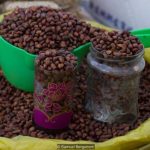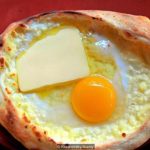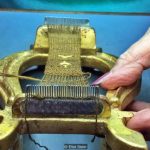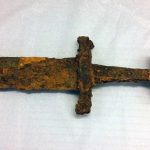Shad bakes are a dance of heat and timing that have been going on for generations up and down the East Coast of the United States for more than 100 years.
Joseph Shea presides over a culinary jigsaw puzzle. He and his apprentices squat around a hexagonal fire, shifting slabs of wood with fish nailed to them against the heat. Flames lick at angled oak planks, coaxing out the oils of the American shad, Connecticut’s state fish, and cooking it to a delicate crust just steps away from where it was spawned.
At a call from the bake master, a fire-tender hoists a numbered plank from the heat source and hurries it across the lawn, where a team of workers unhinge half a dozen fish from their crucifix and pass the plate to the server with assembly-line accuracy: gill to gullet in 30 minutes or less.
This dance of heat and timing has been going on up and down the East Coast of the United States for more than 100 years. Though home-planked shad can be traced back to early 18th-Century cookbooks, large-scale shad bakes similar to Shea’s began in the late 1800s, when savvy travel marketers used the events as a way to entice an emerging middle class to the suburbs for entertainment and a taste of country life.
Today, the tradition is kept alive by civic organisations, most famously in the tiny Connecticut hamlet of Essex, which has held an annual Rotary Club shad bake since 1958.
This unique way of cooking large amounts of shad is a rite of spring in my home state of Connecticut. The filleted fish, its 1,000 tiny bones expertly removed, is nailed to boards and circled around a roaring fire. Angled in such a way and blackened by decades of reuse, the planks help release the excess fish’s oils into a pan below to make the fish light, imparting a flavour that cannot easily be replicated outside of an open fire.
The resulting delicacy, sometimes compared to a lean salmon, requires little else beyond the smoky taste of the fire – and strip of salt pork fat and a smattering of paprika for added flavour, applied to the fish before it hits the flame.
But unlike the more popularly eaten and easily filleted salmon, which shares a similar lifecycle, shad has always been a working man’s dish, said Amy Trout, curator for the Connecticut River Museum who assembled an exhibit on the fish last spring. After spending its life in the North Atlantic’s Sargasso Sea, shad return en masse from April to June to spawn in the rivers of its birth. The sudden springtime appearance of half a million or more fish in rivers up and down the East Coast makes the bony migrant one of the year’s first easy meals after a long winter.
“It was a tradition, even in the colonial days, to stop farming, stop what you were doing and suddenly become fishermen because [shad] was so plentiful,” Trout said. “It was the fish that fed farmers and everyday fishermen and working-class people. It was their fish for that period of time, so it developed this kind of folklore of being the fish of the people of Connecticut.”
Like its New England cohort, the lobster, shad was once served in such plentiful amounts during colonial times that prisoners in the region reportedly rallied against the fish – more than a few days a week was considered culinary punishment – and servants’ contracts limited how often they would eat it, said Chris Dobbs, the Connecticut River Museum’s executive director.
This distaste for something otherwise delectable reflects social positions: because it was so abundant, shad was the food of the poor and thus became a sign of poverty, explained Stephen Olbrys Gencarella, the museum’s folklorist and a University of Massachusetts professor who has studied shad history.
Shad’s abundance and prickly texture, likewise, is tattooed in New England folklore. One story, penned by one of the founders of the Boy Scouts in the early 20th Century, paints the shad as an inside-out porcupine, cast into the rivers by a vengeful spirit. A second, first published in the mid- to late 1800s but possibly older in the oral tradition, tells of shad as the devil’s making: he used all his spare bones on the fish and ran out when it came time for the strawberry, which also appears in springtime abundance.
Around the same time, a Springfield, Massachusetts, resident was said to have had so much to drink at the pub across the river that he missed the last ferry and simply made his way home by walking across the backs of shad.
Perhaps the most well-known tale – and slightly more grounded in historical merit, according to Dobbs – is that George Washington’s troops, battling both foe and famine in their winter encampment at Valley Forge, were saved from certain death after an unusually early thaw tricked the fish upriver for an early spawn. The shad broke their hunger, the troops were saved and the fish helped win the American Revolutionary War.
It’s a story that notes of desperation more than appreciation, Gencarella said.
“It was so integral a fish, it would have been an easy food source,” the folklorist said. “But let’s remember what that means. It means that [shad] is still largely at that time a fish that nobody really wants, although it’s delectable. That story is getting at how desperate things were. So the veracity of the story may be sceptical, but the values behind it are of the perseverance of the colonists.”
This labour-intensive, net-caught fish has since evolved in its catch and preparation from a thing of abundance eaten out of necessity to a seasonal delicacy aligned with community. At the turn of the 20th Century, according to Gencarella, an emerging tourism market among the middle class brought about shad bakes as we know them today: an occasion for get-togethers that highlighted and made use of an abundant local food source.
That tradition radiated along the Atlantic states, from New Jersey to South Carolina. In Washington DC, bakes came with eating contests known as ‘fat-man runs’, carnival games and appearances by politicians on the campaign trail, he said. Northward, New England sensibility made the bake more about local variances in cooking than political fanfare, and deep-seated views on accompanying side dishes (such as what type of pie best complemented the shad) formed a basis for hometown pride.





































